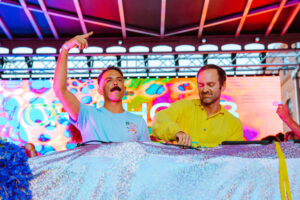It would be great if you could plan your event advertising strategy based on what you wish would happen with your ticket sales — but you know that wishes don’t always come true!
Instead, base your strategy on real results from events like yours. The experts at ToneDen have worked with countless events to refine their marketing strategies, and have identified a sure-fire timeline for event marketing success in the process.
Here’s how to figure out the best timeline to distribute your ad spend across the ticket sales lifecycle.
Properly distribute your ad spend across the event sales cycle
The most important factor in your event advertising plan is the typical event sales cycle.
Every event has an arc – the sales curve that tracks when people buy tickets. For most events, sales spike when tickets first go on sale, because you built up anticipation when you first announced your event. Tickets don’t spike again until the last few days before the event. In between those two periods is a relatively stagnant “maintenance” stage when sales slump.

Understanding these stages is critical to mastering any type of event promotion, especially paid social ads. Your audience has different motivations at each stage of your ticketing lifecycle. It’s your job to nurture their ticket-buying intentions until they’re ready to buy. If you spend all your ad budget in the maintenance period, for example, you won’t see the sales you need.
“One of the biggest mistakes we see event promoters make is to announce an event way in advance and spend a lot of money on the initial ad stage,” says Ali Shakeri, CRO and Co-founder at ToneDen. “But they neglect to harness the interest of initial viewers.”
In other words, you got people to find out about your event — but then didn’t have any spend left to remind them to actually buy tickets once they were ready.
Instead of an “upfront ad blitz” approach, Shakeri recommends tuning in to the nuances of each stage of the ticketing lifecycle. Your strategy should nurture potential ticket buyers to the point of “conversion” — the moment they actually buy tickets.
For a typical event, Shakeri recommends breaking down your ad spend like this:
- 40% Combined on-sale and announce stages
- 20% Maintenance campaigns
- 40% Closeout
Adjust your ad spend based on your event type and its fans
This generic breakdown isn’t a fit for every type of event. Your ad spend should also keep in mind the demographics of your audience.
Here are a few examples of events where you’d approach spend differently:
Tiered ticket events and festivals
Events with more complex ticketing schemes — like festivals with tiered releases of ticket types — might require a more complicated ad strategy.
ToneDen data: For festivals, 15% of tickets sell during the first week, and 24% during the last week. That leaves 61% of tickets selling during tiered ticket-release stages in between.
To capture all types of ticket buyers at such events, you’ll want to spread awareness and inspire conversion at each stage of ticketing:
- 10% Announce
- 30% 1st tier ticket on-sale
- 10% 2nd tier ticket on-sale
- 10% 3rd tier ticket on-sale
- 40% Closeout
Family-friendly events
Family-friendly events often see earlier ticket sales. Older and higher-income audiences tend to plan ahead, so your advertising will lean heavily into early efforts:
- 40% Combined on-sale and announce stages
- 30% Maintenance campaigns
- 30% Closeout
Nightlife or weekend events with last-minute fans
According to the 2019 Pulse Report, the third biggest challenge facing creators – both this year and last – is achieving ticket sales. Filling seats was difficult for 34% of organisers in 2018 and 23% predict it will continue to be a problem in 2019. So selling last-minute tickets can be crucial for your event success.
Comedy shows are a good example of an event that tends to attract last-minute ticket buyers.
ToneDen data: Comedy shows, on average, sell only 6% of tickets in the first week. 75% sell during the last week — and 31% during the last day.
For these shows, you might spend more money up front to encourage people to buy tickets earlier. At the same time, you want to be fresh in the minds of last-minute buyers. So a more appropriate ad spend for such events might look like this:
- 50% Combined on-sale and announce stages
- 10% Maintenance campaigns
- 40% Closeout
These are just rough estimates of how your event’s typical sales cycle might influence the cadence of your ad spend. There are other factors at play as well. For instance, events located in “party cities”, like London and Manchester, have a different sales cycle than those in more conservative cities.
Considering the budget breakdown that makes the most sense for your event is the first step in crafting a killer ad strategy that will ensure you sell out.
Ready to create your ad copy and start promoting? These 51 social media ad copy templates will help!




